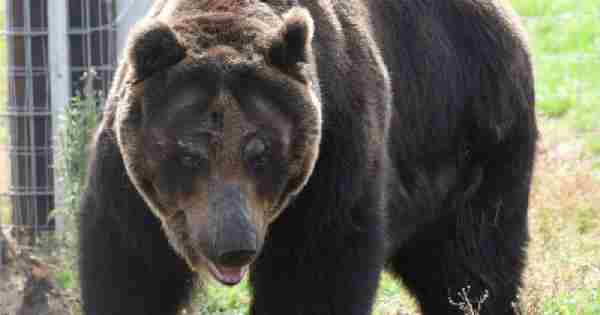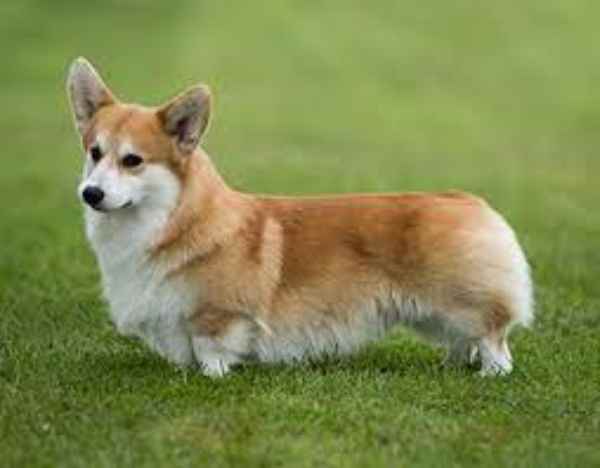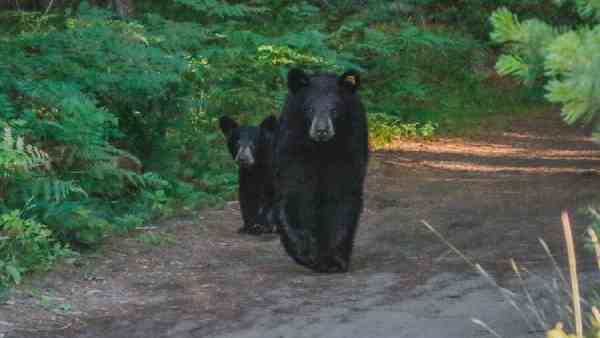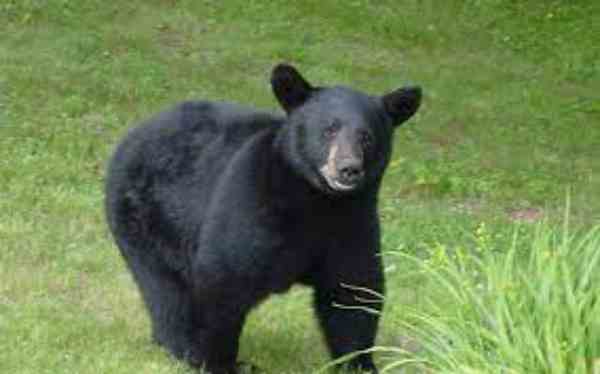Bears and dogs may not immediately seem like two animals that would be related, but it turns out that they actually share a common ancestor. The evolutionary biology of these two creatures is fascinating, as they both evolved from the same family of mammals millions of years ago.
Table of Contents
While bears and dogs have taken very different paths since then, their genetic ties are still present in the features they share, like their sharp teeth and powerful jaws. Even the cuddly chow dog can trace its lineage back to the same ancestors as the fearsome American black bear.
By understanding this connection, we gain a deeper appreciation of the complex and interconnected web of biodiversity that surrounds us.
Evolution of the Bear

Bears have been a prominent figure on Earth for millions of years, with their history dating back to an ancient common ancestor. Nowadays, there are eight different species of bear, ranging from the regal polar bear to the gentle giant panda. Although humans are inadvertently changing the habitats of these magnificent creatures, their adaptability is ensuring their continued prosperity.
They are one of the most dominant predators, commanding the top of the food chain in the diverse ecosystems they call home. These awe-inspiring creatures are powerful yet graceful, and it’s easy to see why bears have captured the imagination of people around the world. Indeed, their resilience and prowess are why it’s crucial to keep finding ways to preserve their habitats. After all, the world is a better place with bears in it.
Evolution of the Dog

Dogs are one of the most fascinating creatures ever to exist, not just for their undeniable cuteness but also for their amazing history that dates back thousands of years. Evidence suggests that modern dogs descended from wolves and were gradually domesticated into beloved companions.
Ancient humans utilized them as hunting companions and helpers, leading to several dog breeds emerging by the middle ages. These intelligent creatures were bred for various functions such as guarding property, herding animals, and protecting hunters. Today, with over 68% of US households owning a pet, the popularity of dogs as loyal companions has never been higher.
Bears and Dogs Are Both Mammals
Bears and dogs indeed share a common classification as mammals within the taxonomic class Mammalia. This classification indicates their biological relationship. However, despite this shared classification, bears and dogs have significant differences.
In terms of size, bears are generally much larger than dogs. On average, bears stand around 7 feet tall, while dogs can vary in size, ranging from smaller than a foot to just over 2 feet at their largest.
Strength is another differentiating factor. Bears possess significantly greater strength compared to dogs. Their powerful physique and muscle mass are adapted for their wild nature, whereas dogs have been domesticated over centuries to serve as companions in human society.
Physically, bears have thick fur coats and powerful claws that enable them to navigate through trees and various terrains. These adaptations are necessary for their survival and lifestyle. On the other hand, dogs typically have thinner fur coats and smaller claws, primarily used for scratching and grooming.
While bears and dogs have distinct physical and behavioural characteristics, both animals contribute to the ecosystem in their unique ways. Despite their external differences, their shared classification as mammals highlights their common biological traits within the Mammalia class.
Bears and Dogs Share Common Ancestors
It is indeed fascinating to learn that bears and dogs share a common ancestor. Through the examination of the fossil record, scientists have been able to gather evidence that sheds light on the evolutionary relationship between these two species.
The ancestral split between bears and dogs occurred millions of years ago, leading to the development of distinct traits and characteristics in each lineage. Despite this divergence, bears and dogs still share a degree of relatedness.
Interestingly, when examining their skeletal features and conducting biological analyses, researchers have discovered that bears are more closely related to dogs than to other carnivores, including cats. This finding highlights the intricate and interconnected nature of biological relationships.
These revelations remind us of the complexity and beauty inherent in the field of biology. The study of evolutionary history allows us to uncover the fascinating connections and shared ancestry among diverse species, providing a deeper understanding of the natural world.
Recent Shared Ancestor Between Dogs and Bears?
It’s remarkable to explore the deep ancestral connections between bears and dogs. While they may appear vastly different today, these animals share a distant common ancestor known as the amphicyonidae, which lived approximately 45 million years ago. The amphicyonidae was a species of large mammals that exhibited traits resembling both canines and ursids.
In 2004, researchers conducted a molecular phylogenetic investigation within the Carnivora group of mammals, leading to the development of a well-supported hypothesis. This hypothesis suggested that bears and dogs share this common ancestor, based on the similarity of their mitochondrial sequences.

Both bear and dog lineages diverged from the amphicyonid around 30-35 million years ago, leading to their separate evolutionary paths. Over time, each species independently adapted and evolved to survive in their respective habitats, resulting in the diverse characteristics we observe today.
The discovery of these ancestral connections deepens our understanding of the shared history between bears and dogs, spanning millions of years. It highlights the ongoing process of evolution and the remarkable diversity that has emerged from a common ancestor.
Bear Breeds That Resemble the Dog
Here are descriptions of a few bear species that, with a little imagination, may bear some resemblance to certain dog breeds:
- American Black Bear: The American black bear is the smallest of the three bear species found in North America. They inhabit wooded areas throughout the United States and Canada. Despite their name, black bears can have fur ranging from light brown to dark brown. They typically weigh between 150 and 600 pounds.
- Brown Bear/Grizzly Bear: The brown bear, also known as the grizzly bear, is the largest of the three bear species in North America. They are found in forests throughout the United States and Canada. Brown bears can have fur ranging from light brown to dark brown, but the most common colouration is dark brown. They are substantially larger than black bears, weighing between 500 and 1,500 pounds.
- Polar Bear: The polar bear is the largest of the three bear species in North America and is primarily found in arctic regions worldwide. These bears have distinct white or cream-coloured fur, which helps them blend into their snowy habitat. Polar bears typically weigh between 1,000 and 2,000 pounds.
- Sloth Bear: The sloth bear is a small bear species found in various wooded habitats in India and Sri Lanka. They have black fur with a light-coloured muzzle. Sloth bears are considerably smaller, weighing between 100 and 200 pounds.
While these bear species may not closely resemble specific dog breeds, it’s interesting to consider their unique characteristics and diversity within the bear family.
These are some dog breeds that, with their appearance, may resemble bears:
- Akita: The Akita is a large breed of dog originating from Japan. It is known for its loyalty and protective nature, as well as its bear-like appearance. Akitas have a strong and sturdy build, with a thick double coat.
- Alaskan Malamute: The Alaskan Malamute is a large breed originally bred for sledging in the Arctic region. They have a thick and dense fur coat, giving them a bear-like appearance. Alaskan Malamutes are known for their strength and endurance.
- Canadian Eskimo Dog: The Canadian Eskimo Dog is a large breed that was historically bred by the Inuit people of Canada. They have a thick coat of fur, with males having particularly dense fur around their necks, resembling a mane. This feature can make them appear larger and more bear-like.
- Chow Chow: The Chow Chow is a large breed originating from China. They have a distinctive appearance with a dense double coat and a blue-black tongue. Chow Chows have a strong and independent personality, often displaying a protective nature towards their owners.
- Eurasier: The Eurasier is a medium-sized breed of dog developed in Germany. It is known for its wolf-like appearance, resulting from a crossbreeding between the Chow Chow and the Wolfspitz. Eurasiers have dense and medium-length coat.
- Samoyed: The Samoyed is a large breed originating from Siberia. While they may not resemble bears as closely as some other breeds, they do possess a thick white double coat that can give them a fluffy and bear-like appearance. Samoyeds are known for their friendly and sociable nature.
While these dog breeds may have certain physical traits that resemble bears, it’s important to note that they are domesticated animals with distinct temperaments and behaviours.

Domestication
Canines have indeed proven to be exceptional working animals throughout history, which is why they have been chosen as close companions by many ancient cultures.
Selective breeding has allowed humans to create highly trained dogs that excel in various tasks such as hunting, guarding property, and providing security. The wide variety of dog breeds seen today is a testament to their successful domestication and adaptation to different environments and purposes.
In contrast, bears cannot be domesticated in the same way as dogs. While they can be trained and conditioned to some extent, true domestication of bears is practically impossible under ethical and humane circumstances. Bears have a predatory nature and are large in size, which poses inherent risks and challenges in keeping them as domesticated animals.
The immense amounts of food they require on a daily basis make their maintenance and care in a domestic setting unfeasible. Additionally, bears are primarily solitary animals, and their breeding patterns in captivity are difficult to replicate. They are apex predators that have evolved to violently attack and dismember prey, which further adds to the challenges of domestication.
It is important to recognize the distinct characteristics and limitations of different species when considering their potential for domestication and suitability as working animals. Dogs have a long history of coexistence and partnership with humans, whereas bears remain wild animals with specialized behaviours and needs.
Relationship Between Bears and Dogs: Habitat
Bears and dogs do indeed have distinct geographic distributions, with some overlapping habitats depending on the specific breed and region. Bears are predominantly found in North America, Europe, Asia, and parts of South America. They thrive in forested mountainous areas, with species like black bears and brown bears being particularly abundant in these regions.
In contrast, dogs are considered cosmopolitan species, meaning they have adapted to various regions worldwide. They can be found in Arctic climates, hot deserts, and virtually every other type of habitat. The adaptability of dogs and their domestication by humans has allowed them to inhabit diverse environments globally. Certain breeds, such as huskies, are well-suited to colder regions like the Alaskan tundra, while other breeds excel in warmer climates.
While there may be some overlap between the habitats of bears and certain dog breeds in specific regions, the general distribution patterns of these species are distinct. Bears tend to be more restricted in their ranges, primarily inhabiting specific regions, whereas dogs have a much broader distribution and can be found in a wide range of environments.
Overall, bears and dogs occupy different areas of the world, reflecting their unique evolutionary adaptations and historical interactions with humans.
Bears Have Been Known to Interact with Dogs
Interactions between bears and dogs can indeed occur, and the nature of these interactions can vary depending on the individuals involved and the specific circumstances. Bears may view dogs as either threats or potential playmates, depending on their own behaviour and the context of the encounter.
Such interactions are relatively rare and are more likely to happen in areas with minimal human intervention and where bears and dogs coexist in the same habitat. In some cases, bears have been observed befriending domesticated dogs that were not perceived as a threat. These interactions typically occur when the bears are accustomed to the presence of dogs and do not perceive them as a source of danger.
However, it is important to note that bears are wild animals, and their behaviour can be unpredictable. While they may display friendly or playful behaviour towards dogs in certain situations, they can still exhibit defensive behaviour if they feel threatened or spooked. It is crucial to respect their wild nature and not attempt to force interactions between bears and dogs.
Studies suggest that a low level of trust may exist between bears and dogs in specific locations and circumstances, but it is important to allow these interactions to occur naturally. Forcing or encouraging interactions between these animals can have severe consequences and lead to dangerous and potentially fatal outcomes.
Given the potential risks and complexities involved, it is essential to prioritize the safety of both animals and avoid situations where bears and dogs come into direct contact unless under controlled and supervised circumstances.

Relationship Between Bears and Dogs: Physical Similarities
While bears and dogs may have some physical similarities, it is important to clarify their relationship and evolutionary history. While both species belong to the order Carnivora, which includes other predators like cats, their specific classifications differ.
- Bears belong to the family Ursidae, while dogs, including domestic dogs and wolves, belong to the family Canidae. While both families are part of the larger Carnivora order, they represent distinct lineages with different evolutionary paths.
- While bears and dogs share certain musculoskeletal structures, such as four legs and five toes on each foot, these characteristics are not exclusive to them and are shared by many mammals. Similarly, forward-facing eyes with good depth perception are advantageous for many predators, including bears and dogs, but are not unique to them.
- It is important to note that while bears are classified as carnivores, many species have adapted to have omnivorous or herbivorous diets. Dogs, on the other hand, are primarily carnivorous, although domestication has led to dietary variations.
- While both bears and dogs have a shared ancestor in the evolutionary history of mammals, their specific lineages have diverged significantly over millions of years. They have adapted to different ecological niches and developed unique characteristics that suit their respective lifestyles.
Overall, while bears and dogs may have some physical similarities and shared characteristics as part of the Carnivora order, their evolutionary histories have led to distinct species with their own distinct families and adaptations.
Relationship Between Bears and Dogs: Behaviour
While there are some behavioural similarities between bears and dogs, it is important to consider their distinct evolutionary paths and ecological adaptations.
Both bears and dogs exhibit strength and protective behaviours, as they are capable of defending themselves and their families. Hunting for food is also a common behaviour in both species, although their hunting strategies and prey preferences differ.
One notable difference is that bears are generally more solitary animals, while dogs are highly social and have a strong inclination for pack behaviour. Dogs have been domesticated by humans for thousands of years and have developed complex social dynamics within their groups.
Vocalizations, including growling and barking, are used by both bears and dogs as forms of communication. These sounds serve various purposes, such as warning signals or expressing dominance or submission. While the vocalizations may sound similar, it is important to note that they have evolved independently in each species and serve different functions.
The behavioural similarities between bears and dogs could be attributed to shared ancestral traits or convergent evolution due to similar ecological pressures. However, it is essential to recognize that these species have distinct evolutionary histories and ecological roles.
Understanding the unique behaviours and characteristics of each species contributes to our appreciation of their remarkable diversity and the fascinating adaptations that have shaped their lives.

Relationship Between Bears and Dogs: Some Key Differences
Bears are indeed significantly larger than dogs. The size difference between bears and dogs is quite substantial, with bears weighing around ten times more on average than dogs.
- Bears have fur, which is a thicker and coarser type of hair that provides insulation and protection. Dogs have hair, which tends to be thinner and less insulating compared to bear fur.
- Bears are generally solitary animals, while dogs are social animals that often live in packs or groups. Bears typically live and forage alone, while dogs have a strong instinct for social interaction and thrive in group settings.
- Bears are known to hibernate in the winter, entering a state of reduced activity to conserve energy during periods of low food availability. Dogs, on the other hand, do not hibernate and maintain their regular activity levels throughout the year.
- Bears have larger and sharper claws compared to dogs, which are primarily used for hunting and climbing. Dogs, while they do have claws, typically use them for digging, gripping surfaces, or self-defence rather than hunting prey.
- These differences highlight the distinct adaptations and behaviours of bears and dogs, reflecting their evolutionary histories and ecological roles. It is important to understand and appreciate these distinctions to better understand and respect these remarkable animals.
Relationship Between Bears and Dogs: Mating
It’s a common question among animal enthusiasts: could a dog and bear mate? Unfortunately, the answer is a scientific no. While it’s true that some mammals in the same family can interbreed, such as cats and tigers, animals belonging to different families cannot do this. The reason for this is that each animal family has a unique set of chromosomes that are incompatible with those of other families.
Although there have been rare cases of interbreeding resulting in offspring in the past, they are typically infertile and unable to pass on their mixed genetic traits. It’s important for animal lovers to understand the limitations of interbreeding not only for scientific reasons but also for the health and well-being of the animals themselves.
Resemblance of Bears and Dogs
When comparing bears and dogs, it’s easy to notice some similarities in their physical characteristics and eating habits. However, upon closer inspection, the differences between the two species become quite apparent. Dogs are known for their erect ears and loud barking, while bears have flattened ears and emit low growls when necessary.
One of the most significant differences is that bears mate exclusively during the summer months, whereas dogs can mate all year round. While both animals share some commonalities, it’s clear that their unique anatomies and behaviours set them apart. Understanding these differences is essential for proper care and management of these magnificent creatures, whether they’re pets or living in the wild.
FAQs
Are bears closer to dogs?
When it comes to their physical characteristics, bears and dogs do share some similarities, such as their broad muzzles and sharp teeth. However, the two species have distinct differences that set them apart. Bears are considered to be more closely related to seals and sea lions, while dogs are part of the Canidae family, which includes wolves and foxes.
What animal is closely related to bears?
Scientists have determined that the animal that is most closely related to bears is the spectacled bear’s less widely known cousin, the Andean bear. Despite their similarities, the two animal species have significant differences that are worth noting. The Andean bear, for instance, has a shorter snout, rounder ears, and a more herbivorous diet than its more carnivorous relative, the brown bear.
Are wolves and bears related?
Yet, despite their many similarities, they are not closely related. While both are mammals belonging to the order Carnivora, wolves are part of the family Canidae, which includes dogs and foxes, while bears are part of the family Ursidae, which includes pandas and raccoons. Despite this distinction, both wolves and bears occupy important niches in their ecosystems and play critical roles in maintaining a healthy balance of flora and fauna.
Final Words
The genetic similarities between bears and dogs suggest that the two species share a common ancestor. However, despite this genetic connection, the behaviours and physical characteristics of these animals have diverged significantly over time. Compared to bears, dogs exhibit complex social behaviour and come in endless variations of shape, size, and coat colour.
Fascinatingly, researchers are still uncovering the evolutionary origins of these two species. With continuous breakthroughs in DNA research and the discovery of new fossils, we will undoubtedly gain deeper insights into their shared lineage and the unique paths each species has taken. There is no doubt that the relationship between dogs and bears is a captivating tale, one that we will continue to unravel and learn from for years to come.
Reference:
- https://www.sciencefocus.com/nature/why-have-big-cats-evolved-but-not-big-dogs
- https://www.cbc.ca/news/canada/british-columbia/bear-attack-bella-coola-dog-human-grizzly-interactions-bc-wildlife-safety-1.4879813
- https://bearwithus.org/understanding-bears/some-things-to-remember-about-ontario%E2%80%99s-black-bears/
A motivated philosophy graduate and student of wildlife conservation with a deep interest in human-wildlife relationships, including wildlife communication, environmental education, and conservation anthropology. Offers strong interpersonal, research, writing, and creativity skills.










